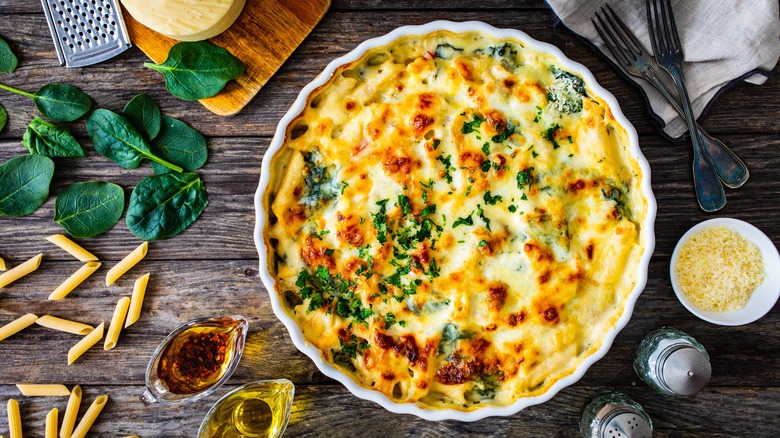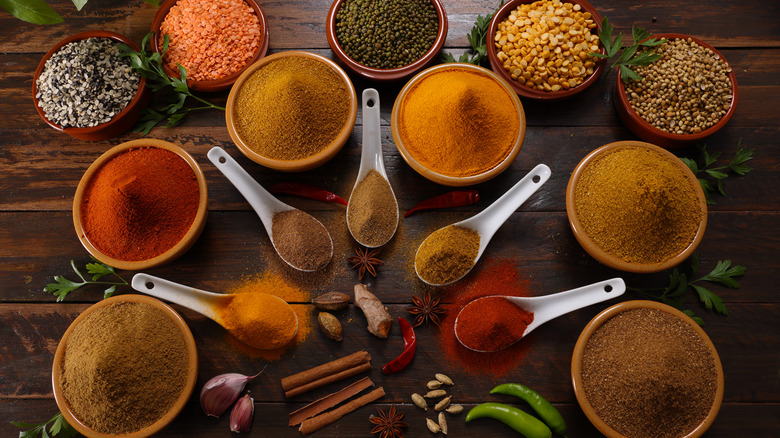When It Comes To Casseroles, Don't Be Shy With The Spices
What's better than a savory baked meal? A savory baked meal that's layered and stacked as tall as a castle, of course. Yes, we're talking about casseroles. An everything-but-the-kitchen-sink potluck favorite, casseroles are versatile, comforting, and convenient. Baking a casserole is as easy as piling proteins, veggies, cheese, and starches into neat layers in a baking dish before cranking up the oven to give it a nice, melty char. However, you may have noticed something is missing from that quintessential lineup of casserole ingredients: spices. As much as we love them, casseroles often lack the depth of flavor that spices bring to dishes.
Next time you're craving a one-pot casserole, don't be shy with the spices. It might seem like meat, cheese, carbs, and veggies melted down into a uniform meal would culminate in forkfuls of flavor, but without spices and seasonings, your casserole will fall flat. Spices and seasonings bring subtle shades of complexity to casseroles by quietly transforming the flavor of the dish. But it's never just random. When you make conscious spice selections informed by how a particular spice or seasoning complements and works with the specific ingredients in your casserole, you can amplify the natural flavors of those ingredients.
Tips for spicing up casseroles
Instead of sprinkling spices on the finished product, inject the casserole with flavors from the inside out by spicing up individual components of the casserole — seasoning the meat while cooking it (pro tip: Always cook your casserole meat before baking it) or adding spices to sautéed vegetables builds layers of flavor throughout the entire dish. You can even add spices to shredded cheese to give dimension to its creamy richness or add seasonings to crispy, toasted casserole toppers for a flavor-blasted crunch.
Seasoning food is a delicate dance: You want to elevate, not overpower your casserole. Consider the overall flavor profile you want to achieve and balance the spices accordingly. For example, if you're using spicy ingredients like chili powder or cayenne pepper, balance them with sweeter elements like brown sugar or aromatic spices like cumin and paprika.
Finally, don't forget salt. Salt does more than provide a brackish taste to dishes. It's also considered a flavor enhancer, bolstering the overall palate of the casserole for more robust bites.
Spice combos for classic casseroles
Casserole combinations are infinite — if you can dream it, you can ... casserole it ...? But for the sake of educational purposes, let's discuss spice combinations for some classic casseroles.
Thanksgiving fans know this one: green bean casserole. Typically made with, you guessed it, green beans, cream of mushroom, fried onion strings, and pepper. Instead of just using black pepper, give this holiday classic a flavorful flair by incorporating spices that preserve the modest nature of this unpretentious casserole. Adding garlic powder, onion powder, a dash of smoked paprika, and salt to taste is an easy way to give it a more robust flavor profile with an allium twist and gentle whispers of smokiness that manage to maintain the unruffled integrity of this timeless casserole.
Next up: baked spaghetti. Go all in with seasoning and spicing up the ground protein in this Italian-American one-pot dish. Cumin gives ground meat a warming, nutty flavor, while chili powder can add fire. Don't sleep on oregano and ground basil to give both the ground meat and sauce a proper Italian touch and wafts of aromatic grassiness.
Here's a tricky one: tuna casserole. Tuna has a bold, oceanic flavor on its own, but a combination of lemon pepper, thyme, and dill can give it a refreshing essence that uplifts the fish rather than weighing it down. Remember, everyone's tastes are different. Figure out which spice blends speak to your senses, and you'll never bake a bland casserole again!


